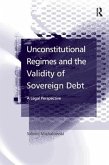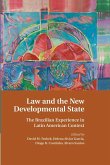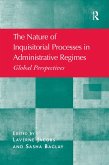Non-State Actors, Soft Law and Protective Regimes
From the Margins
Herausgeber: Bailliet, Cecilia M.
Non-State Actors, Soft Law and Protective Regimes
From the Margins
Herausgeber: Bailliet, Cecilia M.
- Broschiertes Buch
- Merkliste
- Auf die Merkliste
- Bewerten Bewerten
- Teilen
- Produkt teilen
- Produkterinnerung
- Produkterinnerung
This volume of essays examines challenges presented by non-state actors, quasi-legal norms, and gaps within normative and institutional frameworks.
Andere Kunden interessierten sich auch für
![African Regional Trade Agreements as Legal Regimes African Regional Trade Agreements as Legal Regimes]() James Thuo GathiiAfrican Regional Trade Agreements as Legal Regimes62,99 €
James Thuo GathiiAfrican Regional Trade Agreements as Legal Regimes62,99 €![Unconstitutional Regimes and the Validity of Sovereign Debt Unconstitutional Regimes and the Validity of Sovereign Debt]() Sabine MichalowskiUnconstitutional Regimes and the Validity of Sovereign Debt32,99 €
Sabine MichalowskiUnconstitutional Regimes and the Validity of Sovereign Debt32,99 €![Hard Choices, Soft Law Hard Choices, Soft Law]() John J. KirtonHard Choices, Soft Law80,99 €
John J. KirtonHard Choices, Soft Law80,99 €![Law and the New Developmental State Law and the New Developmental State]() Law and the New Developmental State65,99 €
Law and the New Developmental State65,99 €![The Nature of Inquisitorial Processes in Administrative Regimes The Nature of Inquisitorial Processes in Administrative Regimes]() Laverne JacobsThe Nature of Inquisitorial Processes in Administrative Regimes68,99 €
Laverne JacobsThe Nature of Inquisitorial Processes in Administrative Regimes68,99 €![Constitution and By-laws of the Bark Lake Protective Association [microform] Constitution and By-laws of the Bark Lake Protective Association [microform]]() Constitution and By-laws of the Bark Lake Protective Association [microform]16,99 €
Constitution and By-laws of the Bark Lake Protective Association [microform]16,99 €![Legitimacy and Legality in International Law Legitimacy and Legality in International Law]() Jutta BrunneeLegitimacy and Legality in International Law71,99 €
Jutta BrunneeLegitimacy and Legality in International Law71,99 €-
-
-
This volume of essays examines challenges presented by non-state actors, quasi-legal norms, and gaps within normative and institutional frameworks.
Hinweis: Dieser Artikel kann nur an eine deutsche Lieferadresse ausgeliefert werden.
Hinweis: Dieser Artikel kann nur an eine deutsche Lieferadresse ausgeliefert werden.
Produktdetails
- Produktdetails
- Verlag: Cambridge University Press
- Seitenzahl: 318
- Erscheinungstermin: 6. Januar 2014
- Englisch
- Abmessung: 229mm x 152mm x 17mm
- Gewicht: 463g
- ISBN-13: 9781107416901
- ISBN-10: 1107416906
- Artikelnr.: 40949612
- Herstellerkennzeichnung
- Libri GmbH
- Europaallee 1
- 36244 Bad Hersfeld
- gpsr@libri.de
- Verlag: Cambridge University Press
- Seitenzahl: 318
- Erscheinungstermin: 6. Januar 2014
- Englisch
- Abmessung: 229mm x 152mm x 17mm
- Gewicht: 463g
- ISBN-13: 9781107416901
- ISBN-10: 1107416906
- Artikelnr.: 40949612
- Herstellerkennzeichnung
- Libri GmbH
- Europaallee 1
- 36244 Bad Hersfeld
- gpsr@libri.de
Introduction Cecilia M. Bailliet; Part I. Protection Gaps within
International Criminal Law: 1. Creating international law: gender as new
paradigm Catherine MacKinnon; 2. Legal redress for children on the front
line: the invisibility of the female child Christine Byron; 3.
Understanding the post-conflict terrain for women in the context of
prevailing gender hierarchies: stereotypes and masculinities Fionnuala Ni
Aoláin; 4. Who is the most able and willing? Complementarity and victim
reparations at the International Criminal Court Edda Kristjánsdóttir; Part
II. Measuring the Impact of Non-State Actors within International Human
Rights: 5. What is to become of the human rights-based international order
within an age of neo-medievalism? Cecilia M. Bailliet; 6. Productive
tensions: women's rights NGOs, the 'mainstream' human rights movement, and
international lawmaking Karima Bennoune; 7. Transnational lawmaking in Oslo
- Norwegian-Pakistani women at the interface Anne Hellum; Part III.
Confronting the Challenge of Environmental Protection, Climate Change, and
Sustainable Development: New Actors and Shifting Norms: 8. The creation of
international law of climate change: complexities of sub-state actors Hari
M. Osofsky; 9. International environmental law and soft law: a new
direction or a contradiction? Sumudu Atapattu; 10. Assuming away the
problem: grappling with the vexing relationship between international trade
and environmental protection Rebecca Bratspies; 11. Quo vadis, Europe? The
significance of sustainable development as objective, principle and rule of
EU law Beate Sjåfjell; 12. Conclusion Hilary Charlesworth.
International Criminal Law: 1. Creating international law: gender as new
paradigm Catherine MacKinnon; 2. Legal redress for children on the front
line: the invisibility of the female child Christine Byron; 3.
Understanding the post-conflict terrain for women in the context of
prevailing gender hierarchies: stereotypes and masculinities Fionnuala Ni
Aoláin; 4. Who is the most able and willing? Complementarity and victim
reparations at the International Criminal Court Edda Kristjánsdóttir; Part
II. Measuring the Impact of Non-State Actors within International Human
Rights: 5. What is to become of the human rights-based international order
within an age of neo-medievalism? Cecilia M. Bailliet; 6. Productive
tensions: women's rights NGOs, the 'mainstream' human rights movement, and
international lawmaking Karima Bennoune; 7. Transnational lawmaking in Oslo
- Norwegian-Pakistani women at the interface Anne Hellum; Part III.
Confronting the Challenge of Environmental Protection, Climate Change, and
Sustainable Development: New Actors and Shifting Norms: 8. The creation of
international law of climate change: complexities of sub-state actors Hari
M. Osofsky; 9. International environmental law and soft law: a new
direction or a contradiction? Sumudu Atapattu; 10. Assuming away the
problem: grappling with the vexing relationship between international trade
and environmental protection Rebecca Bratspies; 11. Quo vadis, Europe? The
significance of sustainable development as objective, principle and rule of
EU law Beate Sjåfjell; 12. Conclusion Hilary Charlesworth.
Introduction Cecilia M. Bailliet; Part I. Protection Gaps within
International Criminal Law: 1. Creating international law: gender as new
paradigm Catherine MacKinnon; 2. Legal redress for children on the front
line: the invisibility of the female child Christine Byron; 3.
Understanding the post-conflict terrain for women in the context of
prevailing gender hierarchies: stereotypes and masculinities Fionnuala Ni
Aoláin; 4. Who is the most able and willing? Complementarity and victim
reparations at the International Criminal Court Edda Kristjánsdóttir; Part
II. Measuring the Impact of Non-State Actors within International Human
Rights: 5. What is to become of the human rights-based international order
within an age of neo-medievalism? Cecilia M. Bailliet; 6. Productive
tensions: women's rights NGOs, the 'mainstream' human rights movement, and
international lawmaking Karima Bennoune; 7. Transnational lawmaking in Oslo
- Norwegian-Pakistani women at the interface Anne Hellum; Part III.
Confronting the Challenge of Environmental Protection, Climate Change, and
Sustainable Development: New Actors and Shifting Norms: 8. The creation of
international law of climate change: complexities of sub-state actors Hari
M. Osofsky; 9. International environmental law and soft law: a new
direction or a contradiction? Sumudu Atapattu; 10. Assuming away the
problem: grappling with the vexing relationship between international trade
and environmental protection Rebecca Bratspies; 11. Quo vadis, Europe? The
significance of sustainable development as objective, principle and rule of
EU law Beate Sjåfjell; 12. Conclusion Hilary Charlesworth.
International Criminal Law: 1. Creating international law: gender as new
paradigm Catherine MacKinnon; 2. Legal redress for children on the front
line: the invisibility of the female child Christine Byron; 3.
Understanding the post-conflict terrain for women in the context of
prevailing gender hierarchies: stereotypes and masculinities Fionnuala Ni
Aoláin; 4. Who is the most able and willing? Complementarity and victim
reparations at the International Criminal Court Edda Kristjánsdóttir; Part
II. Measuring the Impact of Non-State Actors within International Human
Rights: 5. What is to become of the human rights-based international order
within an age of neo-medievalism? Cecilia M. Bailliet; 6. Productive
tensions: women's rights NGOs, the 'mainstream' human rights movement, and
international lawmaking Karima Bennoune; 7. Transnational lawmaking in Oslo
- Norwegian-Pakistani women at the interface Anne Hellum; Part III.
Confronting the Challenge of Environmental Protection, Climate Change, and
Sustainable Development: New Actors and Shifting Norms: 8. The creation of
international law of climate change: complexities of sub-state actors Hari
M. Osofsky; 9. International environmental law and soft law: a new
direction or a contradiction? Sumudu Atapattu; 10. Assuming away the
problem: grappling with the vexing relationship between international trade
and environmental protection Rebecca Bratspies; 11. Quo vadis, Europe? The
significance of sustainable development as objective, principle and rule of
EU law Beate Sjåfjell; 12. Conclusion Hilary Charlesworth.







![Constitution and By-laws of the Bark Lake Protective Association [microform] Constitution and By-laws of the Bark Lake Protective Association [microform]](https://bilder.buecher.de/produkte/66/66135/66135468m.jpg)
